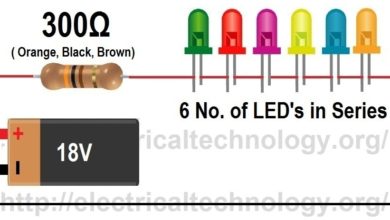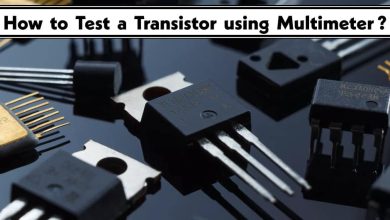PIN Diode – Working, Construction, and Applications
PIN Diode: It’s Symbol, Working, Construction, Characteristics, Advantages, Disadvantages and Applications
A diode (AKA PN Diode) is a two-terminal semiconductor device that allows current in only one direction. There are several types of diodes. A conventional diode often called a PN diode has only two layers. The PIN diode is a modified form of the PN diode that has a third semiconductor layer sandwiched between them. This extra layer enables the PIN diode to detect and convert optical signals into electrical signals.
What is a PIN Diode?
A PIN diode is a special type of diode made from three different semiconductor layers. It is made by placing an intrinsic semiconductor layer (I) between the P-type and N-type semiconductor layers. Hence it is named PIN diode.
The middle intrinsic layer is an undoped semiconductor crystal of silicon or germanium. It is highly resistive and offers high voltage handling capabilities as well as increases the junction width to reduce its capacitance. Therefore PIN diode has a high switching speed. Another ability of the intrinsic region is that it is photosensitive and generates electric current from light.
Related Posts:
- What is Diode? Construction and Working of PN Junction Diode
- Types of Diodes and Their Applications – 24 Types of Diodes
Symbol
The symbol of a PIN diode resembles a generic PN diode with a tilted bar on top. The two terminals anode and cathode are shown in the figure below.
Construction
The PIN diode is made from three layers of semiconductor material i.e. P-layer, intrinsic layer and N-layer of semiconductor. The intrinsic layer is a pure semiconductor crystal with no impurities. Whereas the P-type and N-type semiconductor layers are formed by doping the intrinsic semiconductor with trivalent and pentavalent impurities respectively.
There are two methods used for the manufacturing of the PIN diode i.e. Mesa type structure and planar structure.
In mesa type structure, the two layers P and N are separately grown on top of the intrinsic layer to form a PIN structure. This manufacturing method helps reduce the charge carriers’ recombination effect. Therefore the diode has much lower resistance, lower capacitance and better switching speed.
In a planar structure, A very thin layer of P-type and N-type semiconductor layer is imposed on each side of the intrinsic material.
Related Posts:
- Fast Recovery Diode: Construction, Working and Applications
- Step Recovery Diode – SRD: Construction, Working and Applications
Working
The operation of a PIN diode is almost similar to a conventional PN diode except for the extra middle layer. This middle intrinsic layer increases the gap between the P-type and N-type layer thus increasing the junction width.
Under no bias condition, there is no potential applied across the diode. The P-region has holes as majority carriers while the N-region has electrons as majority carriers. where the middle intrinsic region is free of carriers or the number of electrons and holes are equal. thus acting as an insulating layer between them. Therefore neither holes nor electrons pass through the barrier.
Forward Bias
In forward bias, the anode or P-region is connected with the positive, and the cathode or N-region is connected with the negative terminal of the battery. The applied potential generates an electric field across the barrier in such a way as to push the holes and electrons toward the junction. This causes the junction width to reduce. The holes and electrons combine to result in the flow of current. The current flow reduces the resistance of the diode thus making it a variable resistor in forward bias.
Since the intrinsic layer increases the junction width, it requires a large electric field to increase the carrier concentration in the junction required for current flow. This high electric field helps in increasing the speed of the charge carriers along the length of the diode. This increases the switching speed of the device making it suitable for high-frequency application.
The conductivity of the PIN diode increases with the increase in the applied voltage due to the increase in the injection of charge carriers into the junction. Therefore it acts as a variable resistor in forward bias.
Reverse Bias
In reverse bias, the anode or P-region is connected to the negative, and the cathode or N-region is connected to the positive terminal of the battery. The applied reverse potential pulls away the carriers from the junction increasing the depletion width until the intrinsic region is free of carriers. The voltage at which the charge carriers are completely removed from the intrinsic region is known as swept voltage.
Since there are no carriers in the intrinsic layer, the charge carriers cannot pass through blocking the current flow through the diode. The charge is stored between the two semiconductor layers P and N that act as the capacitor’s plates and the I-layer as the dielectric. Therefore, in reverse bias, the PIN diode acts as a capacitor. Where the junction capacitance is given by
Cj = εA/w
Where
Cj = junction capacitance
ε = permeability of junction
A = area of the junction
w = width of the junction
Due to the addition of an intrinsic layer, the depletion width is very large in reverse bias. This depletion width is free of charge carriers thus blocking the current flow and making it a perfect switch. On the other hand, the large depletion width increases the voltage-blocking capacity of the device. Therefore PIN diode can handle the large voltage.
Related Posts:
- Schottky Diode: Construction, Working, Advantages and Applications
- Shockley Diode: Construction, Working, Characteristics and Applications
Equivalent Circuit
Due to the presence of the intrinsic layer in the PIN diode, its electrical properties drastically vary. Throughout its whole operation, its resistance varies from a few ohms to hundreds of mega ohms depending on the applied voltage. In reverse bias, it even acts as an insulator. It acts as a variable resistor whose resistance depends on the current flow.
In forward bias, the majority carriers from the P-region and N-region are injected into the intrinsic region. These charge carriers in the intrinsic region do not combine quickly but rather take some time called the lifetime of the carriers. Since the presence of the charge carriers in the intrinsic region reduces its resistance, the PIN diode acts as a variable resistor Rs in forward bias.
In reverse bias, the charge carriers are swept away from the intrinsic region due to the applied reverse potential. This intrinsic region acts as an insulator between the two P and N layers that act as conducting plates. Therefore, the intrinsic layer acts as a large resistance Rp in parallel with the total capacitance Ct of the diode.
VI Characteristics of PIN Diode
The VI characteristic curve shows the relationship between the voltage and current through the diode. The horizontal axis shows voltage and the vertical axis shows current as shown in the graph below.
The given graph is divided into two regions; forward bias region and reverse bias region. In forward bias, the diode does not conduct current unless the applied voltage exceeds the forward voltage drop Vf of the diode which is relatively larger than the PN diode due to the larger gap. The forward voltage for PIN diode is around 1.4 V.
In reverse bias, the diode blocks the current flow except for the leakage current IR until the applied voltage exceeds the breakdown voltage VBD. The breakdown voltage of the PIN diode is relatively larger than the PN diode. The breakdown voltage VBD is approximately around 400 volts.
Related Posts:
- LED – Light Emitting Diode: Construction, Working, Types and Applications
- Photodiode: Types, Construction, Operation, Modes, Performance and Applications
PIN Diode Frequency Response
The PIN diode frequency response varies with an increase in the frequency. As we know the intrinsic layer allows current flow as long as there are charge carriers in it. But if the charge carriers are completely swept away from the intrinsic layer, their resistance increases to become an insulator.
In the case of low frequency, there is enough time for the charge carriers to be completely removed from the intrinsic layer thus resistance is high.
In case of high frequency, there isn’t enough time to completely remove the charge carriers therefore, the junction’s resistance reduces. The resistance further decreases with an increase in the frequency.
Therefore, the PIN diode acts as a variable insulator whose resistance ranges between 100 Ω and 10 kΩ.
Advantages and Disadvantages
Advantages
The PIN diode has some advantages over the conventional PN junction diode due to the extra intrinsic layer. Here are some of the advantages
- The PIN diode has a very good performance at high frequencies.
- It can handle or block high reverse voltage.
- The intrinsic layer is sensitive to photons. Thus it is used as a photodetector.
- The reverse leakage current is very small.
- It can be used as a variable resistor in forward bias.
- It has small junction capacitance with a fast response time.
- It produces less noise in the system.
Disadvantages
Here are the disadvantages of PIN diode
- The response time is not as fast as Schottky or fast switching diode.
- Its performance varies with the temperature.
- It has a large reverse recovery time that causes increased power loss.
- The active region, the intrinsic area is small.
- It is less sensitive and thus requires amplification of weak signals.
Applications
Due to the extra intrinsic layer in the PIN diode, they are used in several applications where some of them are given below.
High-Frequency Applications: The middle intrinsic layer increases the depletion region causing to reduce the capacitance of the junction. Whereas the capacitance is inversely proportional to the switching speed or frequency of the device. Therefore the PIN diode is used for the rectification of high-frequency signals such as RF, microwave switches and attenuators, etc.
High Voltage: the intrinsic layer increases the depletion region which results in increasing the reverse voltage handling ability of the diode. Therefore it is used for rectification of high voltage.
Photo Detection: The intrinsic region provides a large depletion region in the PIN diode. When a photon hits the depletion region of the diode it generates an electron-hole pair that moves in opposite directions generating current. Since it has a large depletion region, the PIN diode has increased efficiency in converting light into electrical current. Therefore it is used as a photodetector in photovoltaic cells, fiber optic circuits, etc.
Related Posts:
- Point Contact Diode – Working, Construction, and Applications
- Constant Current Diode – Working, Construction, and Applications
- Gunn Diode: Symbol, Construction Working and Applications
- Varactor Diode – Symbol, Construction, Working and Applications
- Backward Diode: Construction, Operation, Characteristics and Applications
- What is a Laser Diode? Construction, Working, Types and Applications
- What is Avalanche Diode? Construction, Working, Types and Applications
- Tunnel Diode: Construction, Working, Advantages, and Applications
- Zener Diode – Symbol, Construction, Circuit, Working and Applications
- Blocking Diode and Bypass Diodes in a Solar Panel Junction Box
- Diode Formulas and Equations – Zenner, Shockley and Rectifier
- Diode Symbols – Electronic and Electrical Symbols
- Applications of Diodes











